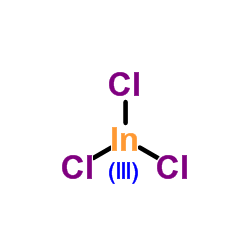Formula InCl3 Melting point 586 °C Boiling point 800 °C | Molar mass 221.18 g/mol Density 3.46 g/cm³ Appearance white flakes | |
 | ||
Indium(III) chloride is the chemical compound with the formula InCl3. This colorless salt finds some use in organic synthesis as a Lewis acid. It is also the most available soluble derivative of indium.
Contents
Synthesis and structure
Being a relatively electropositive metal, indium reacts quickly with chlorine to give the trichloride. Indium trichloride is very soluble and deliquescent. A synthesis has been reported using an electrochemical cell in a mixed methanol-benzene solution.
Like AlCl3 and TlCl3, InCl3 crystallizes as a layered structure consisting of close-packed chloride arrangement containing layers of octahedrally coordinated In(III) centers. The motif is akin to that seen for YCl3. In contrast, GaCl3 crystallizes as dimers containing Ga2Cl6. Molten InCl3 conducts electricity, whereas AlCl3 does not as it converts to the molecular dimer, Al2Cl6.
Reactions
InCl3 is a Lewis acid and forms complexes with donor ligands, L, InCl3L, InCl3L2, InCl3L3. For example with chloride ion it forms tetrahedral, InCl4−; trigonal bipyramidal, InCl52− and octahedral InCl63−.
In diethyl ether solution InCl3 reacts with lithium hydride, LiH, to form
Trimethylindium, InMe3 can be produced by reacting InCl3 in diethyl ether solution either with the grignard reagent,
InCl3 reacts with indium metal at high temperature to form lower valent indium chlorides, In5Cl9, In2Cl3 and InCl.
Catalyst in chemistry
Indium chloride is a Lewis acid catalyst in organic reactions such as Friedel-Crafts acylations and Diels-Alder reactions. As an example of the latter The reaction proceeds at room temperature, with 1 mole% catalyst loading in an acetonitrile-water solvent mixture. The first step is a Knoevenagel condensation between the barbituric acid and the aldehyde, the second step is a reverse electron-demand Diels-Alder reaction.
which is a multicomponent reaction of N,N'-dimethyl-barbituric acid, benzaldehyde and ethyl vinyl ether. With catalyst the reported chemical yield is 90% and the percentage trans isomer is 70%. Without the catalyst added the yield drops to 65% with 50% trans product.
